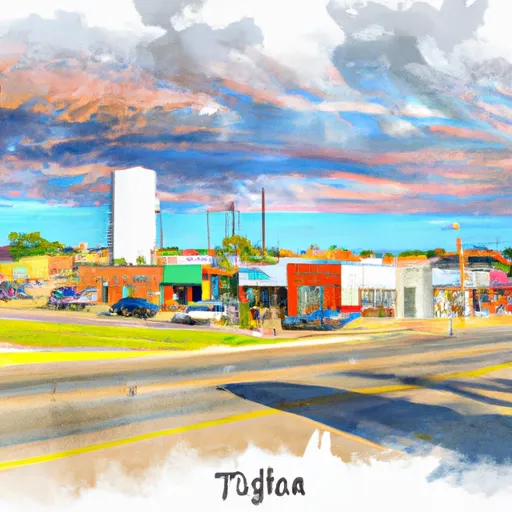-
 Snoflo Premium
Snoflo Premium
Get unlimited access to all our content
With no Ad interruptions! - Start Your Free Trial Login with existing account
Taloga
Eden Index
Climate
8.3
•
Recreation
•
Community
1.6
•
Safeguard
3.7/10

Taloga, Oklahoma is a small town located in Dewey County. The area experiences a humid subtropical climate, characterized by hot summers and mild winters. Summers are typically hot with temperatures often reaching the mid to upper 90s Fahrenheit, while winters are generally mild with temperatures rarely dropping below freezing.
As for hydrology constituents, Taloga is located in the Washita River watershed. The river serves as a vital water source for the town and surrounding areas, supporting agriculture and providing recreational opportunities like fishing and boating.
Taloga offers various outdoor recreation opportunities for nature enthusiasts. The nearby Roman Nose State Park is a popular destination, providing opportunities for camping, hiking, and wildlife photography. Visitors can explore scenic trails that wind through canyons and mesas, or enjoy activities such as swimming, golfing, and horseback riding. The park also features natural springs, providing a serene atmosphere for relaxation and rejuvenation.
Overall, Taloga, Oklahoma offers a pleasant climate, access to the Washita River, and a range of outdoor activities, making it an appealing destination for both residents and visitors.
What is the Eden Index?
The Snoflo Eden Index serves as a comprehensive rating system for regions, evaluating their desirability through a holistic assessment of climate health, outdoor recreation opportunities, and natural disaster risk, acknowledging the profound impact of these factors on livability and well-being.
Climate Health Indicator (CHI): 8.3
Taloga receives approximately
716mm of rain per year,
with humidity levels near 81%
and air temperatures averaging around
15°C.
Taloga has a plant hardyness factor of
6, meaning
plants and agriculture in this region thrive during a short period during spring and early summer. Most
plants will die off during the colder winter months.
By considering the ideal temperature range, reliable water supplies, clean air, and stable seasonal rain or snowpacks, the Climate Health Indicator (CHI) underscores the significance of a healthy climate as the foundation for quality living.
A healthy climate is paramount for ensuring a high quality of life and livability in a region, fostering both physical well-being and environmental harmony. This can be characterized by ideal temperatures, reliable access to water supplies, clean air, and consistent seasonal rain or snowpacks.
Weather Forecast
Streamflow Conditions
Lower Canadian
Area Rivers
Lower Canadian
Snowpack Depths
Lower Canadian
Reservoir Storage Capacity
Lower Canadian
Groundwater Levels
Recreational Opportunity Index (ROI):
The Recreational Opportunity Index (ROI) recognizes the value of outdoor recreational options, such as parks, hiking trails, camping sites, and fishing spots, while acknowledging that climate plays a pivotal role in ensuring the comfort and consistency of these experiences.
Access to outdoor recreational opportunities, encompassing activities such as parks, hiking, camping, and fishing, is crucial for overall well-being, and the climate plays a pivotal role in enabling and enhancing these experiences, ensuring that individuals can engage in nature-based activities comfortably and consistently.
Camping Areas
| Campground | Campsites | Reservations | Toilets | Showers | Elevation |
|---|---|---|---|---|---|
| Foss State Park | None | 1,705 ft | |||
| Hobart Lions Club RV Park | 8 | 1,546 ft | |||
| Alabaster Caverns State Park | None | 1,726 ft | |||
| Little Sahara State Park | None | 1,463 ft | |||
| Cordell Park | None | 1,530 ft | |||
| Great Plains State Park | None | 1,424 ft |
Nearby Ski Areas
Catastrophe Safeguard Index (CSI):
The Catastrophe Safeguard Index (CSI) recognizes that natural disaster risk, encompassing floods, fires, hurricanes, and tornadoes, can drastically affect safety and the overall appeal of an area.
The level of natural disaster risk in a region significantly affects safety and the overall livability, with climate change amplifying these risks by potentially increasing the frequency and intensity of events like floods, fires, hurricanes, and tornadoes, thereby posing substantial challenges to community resilience and well-being.
Community Resilience Indicator (CRI): 1.6
The Community Resilience Indicator (CRI) recognizes that education, healthcare, and socioeconomics are crucial to the well-being of a region. The CRI acknowledges the profound impact of these elements on residents' overall quality of life. By evaluating educational resources, healthcare accessibility, and economic inclusivity, the index captures the essential aspects that contribute to a thriving community, fostering resident satisfaction, equity, and social cohesion.

